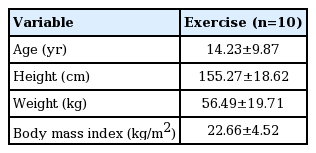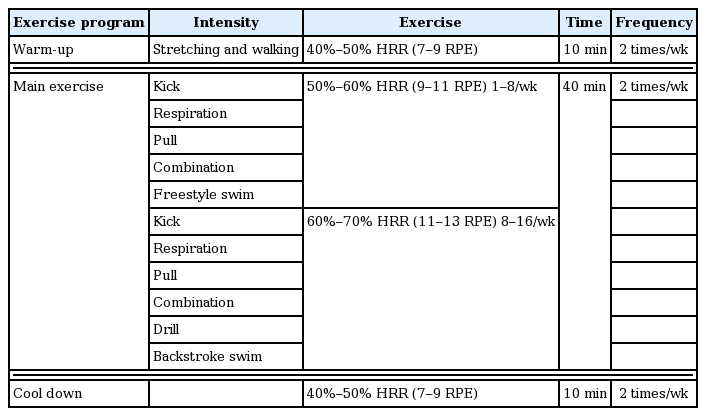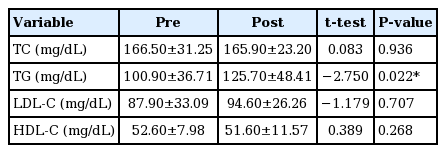Effects of aquatic exercise on health-related physical fitness, blood fat, and immune functions of children with disabilities
Article information
Abstract
The purpose of this study is to verify the effects of aquatic exercise on the health-related physical fitness, blood fat, and immune functions of children with disabilities. To achieve the aforementioned purpose, the researchers studied 10 children with grade 1 or grade 2 disabilities who do not exercise regularly. The researchers used SPSS 21.0 to calculate the averages and standard deviations of the data and performed a paired t-test to verify the differences in averages before and after an exercise. The study showed significant differences in lean body weight, muscular strength, cardiovascular endurance, flexibility, and muscular endurance. The researchers found statistically significant differences in triglyceride as well as in immunoglobulin G. The findings suggest that aquatic exercise affects the health-related physical fitness, blood fat, and immune functions of children with disabilities.
INTRODUCTION
In modern societies, rapid economic development and the advancement of automation technologies have made our daily activities incomparably easier, while driving people to adopt westernized diet patterns. These changes have led to many cases of overnutrition and a wide range of diseases caused by insufficient physical activity.
These issues raised people’s interest in various forms of exercises. Gremeaux et al. (2012) and Scherr et al. (2011) found that regular exercise reduces the risk of cardiovascular diseases and death. In addition, it has been argued that people need to be encouraged to practice aerobic exercises to reduce the risk of these diseases, as they just sit most of the time (Löllgen et al., 2009; Nocon et al., 2008).
Aside from reducing the risk of various diseases, aerobic exercises are recommended to enhance our physical and mental health (Banz et al., 2003). One of the most widely practiced forms of aerobic exercise is aquatic exercise. Aquatic exercises involve less risk of injury than exercises performed on the ground. It also reduces blood retention in the legs and fatigue as it is carried out in a streamlined rather than a standing position. It has also been reported that swimming improves venous return and reduces the risk of heart diseases (Ussher et al., 2003). In addition, the buoyancy, pressure, resistance, and temperature of water maximize the effectiveness of aquatic exercise, and buoyancy allows for lighter and safer body movements (Carroll et al., 2017).
However, Morgado et al. (2017) emphasize the need for special caution when exposed to aggressive environmental factors such as swimming pools. Exercising in such environments may adversely impact our immune functions, in which undermines our ability to fight diseases and increases our sensitivity to chronic diseases.
This need is especially relevant to children with disabilities, who need regular physical activities because they tend to grow more inactive as they grow old, and need continued management (Marshall et al., 2003).
Education on physical activities and movements has significance beyond physical development. It is one of the critical factors that affect the education and growth of children.
Effective physical education is particularly required of children with disabilities, as they are limited in their physical, emotional, and social abilities.
In other words, physical activities have high personal and social significance for children with disabilities. In light of the above, this study seeks to improve the quality of life for children with disabilities and their satisfaction with day to day activities by verifying the effects of aquatic exercise on the health-related physical fitness, blood fat, and immune functions of children with disabilities.
MATERIALS AND METHODS
Subjects
For this study, the researchers studied 10 children with grade 1 and grade 2 disabilities living in Y area, who understood the purpose of this study and signed the consent forms provided by the researchers. Table 1 shows the physical characteristics of the research subjects.
Measurement item and methods
With regard to the physical fitness assessment for this study, muscular strength (strength of grasp), muscular endurance (curl-ups), flexibility (sit and reach), and cardiovascular endurance (20-m shuttle run)—which were also performed in the National Physical Fitness Survey—were conducted twice before and after the exercise. As to blood pressure, systolic and diastolic blood pressures were measured using a mercury sphygmomanometer after stabilization. With regard to the blood lipid, total cholesterol (TC), triglyceride (TG), high-density lipoprotein cholesterol (HDL-C), low-density lipoprotein cholesterol (LDL-C), immunoglobulin (IgG), IgA, and IgM were analyzed through blood collection. Table 2 shows the Items and instruments of the measurement.
Exercise program
The subjects exercised for 16 weeks, twice a week, and each session took 60 min. Table 3 lists the specific activities included in the exercise program.
Data processing
All data were processed using IBM SPSS Statistics ver. 21.0 (IBM Co., Armonk, NY, USA) to calculate their mean values and standard deviations. In addition, a paired t-test was performed to verify the pre-/postexercise effect. The data were analyzed at the statistical significance level (α) of 0.05.
RESULTS
Effect on health-related physical fitness
The researchers verified the differences in lean body weight, muscular strength, cardiovascular endurance, flexibility, and muscular endurance, and found statistically significant differences before and after the exercise (Table 4). However, the subjects did not exhibit any statistically significant difference in body fat, body mass index (BMI), and weight measurement.
Effect on blood fat
The researchers found statistically significant differences in TG before and after the exercise (Table 5). However, the subjects did not exhibit any statistically significant difference in TC, HDL-C, and LDL-C.
DISCUSSION
This study sought to verify the effects of aquatic exercise on the health-related physical fitness, blood fat, and immune functions of children with grade 1 and grade 2 disabilities. The researchers found significant differences in lean body fat, muscular strength, cardiovascular endurance, flexibility, muscular endurance, TG, and IgG. However, no significant difference was found in TC, HDL-C, LDL-C, IgA, and IgM before and after the exercise.
Based on the above findings, the researchers would like to argue the following points.
It is important for us to be physically active so we could lead a healthy life. However, what counts more is that we exercise systemically, with concrete goals to enhance our physical fitness (Batt et al., 2013).
Although of similar physique, children with disabilities are less physically fit than children without disabilities (Yamaki, 2005). They also lack a sense of balance. For these children, aquatic exercise offers a safer way to improve their physical fitness and balance because they can benefit from water buoyancy.
It was reported that aquatic exercise programs have positive effects on the physical fitness and body composition of children with disabilities (Casey et al., 2010; Pan, 2010; Yilmaz et al., 2004). Moreover, physical activity programs were found to have the same effects on their motor skills, physical fitness, and emotional behaviors (Pitetti and Fernhall, 2004).
Health-related physical fitness is essential to our day-to-day activities and motor functions. Such fitness consists of various factors like cardiovascular endurance, muscular strength, muscular endurance, flexibility, and body composition. Among these factors, cardiovascular endurance is the most important as it predicts cardiovascular conditions. The findings of the Santa-Clara et al. (2003) are similar to this study; they reported that exercise enhances our cardiopulmonary functions, improves vessel wall elasticity, and reduces vessel wall damage, thereby improving the overall functioning of our vascular system. Misra et al. (2008) observed a significant TG decrease in subjects who exercised three times a week for 12 weeks. Their findings are also consistent with the present study.
However, the researchers did not find any significant difference in TC, HDL-C, and LDL-C. Durstine et al. (2002) reported that exercise training alone does not significantly reduce TC, and it is not affected by the length of exercise, either.
Meanwhile, Katzmarzyk et al. (2001) reported a TC increase in people who exercise above a certain intensity, on a regular basis, for a prolonged period. These findings suggest that exercising is more effective when it is performed on a continuous basis, at a higher frequency.
Lastly, there are various types of immunoglobulin antibodies that help us diagnose abnormal protein metabolism or lack of resistance to infection. Among these antibodies, aquatic exercise was found to have a significant effect only on IgG, the type that exists in the highest quantity and has the longest life. Shephard and Shek (1995) have suggested that low-intensity exercises improve our immune functions. Therefore, improvement in other immune functions can be achieved by adjusting the intensity of exercise activities.
Overall, the findings of this study suggest that intensity and frequency are two crucial factors for aquatic exercise programs for children with disabilities. If children with disabilities participate in long-term aquatic exercise programs that take their health and fitness in consideration, it is likely that these programs will have positive effects on their health-related physical fitness, blood fat, and immune functions.
Notes
CONFLICT OF INTEREST
No potential conflict of interest relevant to this article was reported.






